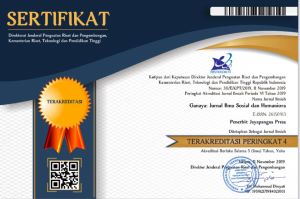Penerapan Model Pembelajaran Grup Investigation (GI) Berbantuan Vidio Pembelajaran Untuk Meningkatkan Hasil Belajar IPA
DOI:
https://doi.org/10.37329/cetta.v3i1.406Keywords:
Group Investigation (GI), Learning OutcomesAbstract
This action research aims: (1) to improve the science learning outcomes of VIIA class students in the even semester of SMP Negeri 1 Manggis in the academic year 2017/2018 by applying the learning investigation (GI) learning model assisted by learning videos. This type of research is classroom action research. The subjects of this study were 30 students in class VIIA, and the object of this study was the science learning outcomes. This action research is planned to be carried out in two cycles. Learning outcomes data were collected using multiple choice tests. Data were analyzed by descriptive analysis. The results showed that: (1) The natural science learning outcomes of the VIIA class in the second semester increased in the first cycle by an average of 70, 70% absorption, with a 50% grade completeness, and an average cycle II of 77, 77 absorption %, with 86.6% class completeness. With the achievement of an average of 77 Natural Science learning outcomes, it means that it is above the established success level of 70, so that the action is considered successful. Thus it can be said that the application of the learning investigation (GI) group learning model assisted by learning videos can improve the learning outcomes of natural science students in class VIIA an even number at SMPN 1 Manggis in the academic year 2017/2018.
References
Erniwati. (2014). Penggunaan media berbasis video dalam pembelajaran IPA-Fisika untuk meningkatkan hasil belajar siswa pada materi pokok Suhu dan Perubahannya. Jurnal Sains Dan Pendidikan Fisika.
Febrianti, E. S., Karyadi, B., & Kasrina, K. (2018). Penerapan Model Kooperatif Tipe-Grup Investigation (GI) Pada Materi Sistem Ekskresi Manusia Untuk Meningkatkan Hasil Belajar Siswa Kelas XI IPA SMA N 8 Kota Bengkulu. Diklabio: Jurnal Pendidikan Dan Pembelajaran Biologi. https://doi.org/10.33369/diklabio.2.1.10-14
Iwantara, I. W. (2013). Pengaruh penggunaan media video youtobe dalam pembelajaran IPA terhadap motivasi belajar dan pemahaman konsep. Program Studi Pendidikan IPA Program Pascasarjana Universitas Pendidikan Ganesha.
Kunandar. (2010). Guru profesional implementasi kurikulum tingkat satuan pendidikan (KTSP) dan persiapan menghadapi sertifikasi guru. Jkarta: PT Raja Grasindo Persada.
Kusumawati, N. A. (2019). Implementasi Teori Multiple Intelegences (Kecerdasan Majemuk) Dalam Pembelajaran Pendidikan Agama Hindu. Satya Widya: Jurnal Studi Agama. https://doi.org/10.33363/swjsa.v2i2.352
Murda. (2012). Multimedia Konsep & Aplikasi dalam Pendidikan Pendidikan.
Nugroho Yuliono, S., Sarwanto, S., & Wahyuningsih, D. (2014). Video Pembelajaran Berbasis Masalah Pada Materi Kalor Untuk Siswa Kelas VII. Jurnal Pendidikan Fisika Universitas Sebelas Maret.
Nuri. (2015). Penerapan model pembelajaran tipe group investigation (GI) dalam pembelajarn IPA untuk meningkatkan ketrampilan kooperatif dan penguasaan materi IPA siswa SMP Negeri 4 Wates.
Purbosari. (2013). Pembelajaran kimia menggunakan model Teams Games Tournament dengan media animasi berbasis Flash dan video interaktif ditinjau dari kemampuan memori dan kreativitas. Jurnal Inkuiri, 225–268.
Sanjaya, W. (2010). Strategi Pembelajaran Berorientasi Standar Proses Pendidikan. Bandung: Kencana Press.
Santyasa, I. W. (2012). Pembelajaran inovatif. Singaraja: Undiksha Press.
Sukiman. (2011). Pengembangan Media Pembelajaran. Yogyajarta: Pedagogia.
Widiantara, K. (2014). Pengaruh Model Pembelajaran Group Investigation Terhadap Hasil Belajar Matematika. Jurnal Mimbar PGSD Universitas Pendidikan Ganesha.
Downloads
Published
How to Cite
Issue
Section
License
An author who publishes in the Cetta : Jurnal Ilmu Pendidikan agrees to the following terms:
- Author retains the copyright and grants the journal the right of first publication of the work simultaneously licensed under the Creative Commons Attribution-ShareAlike 4.0 License that allows others to share the work with an acknowledgement of the work's authorship and initial publication in this journal
- Author is able to enter into separate, additional contractual arrangements for the non-exclusive distribution of the journal's published version of the work (e.g., post it to an institutional repository or publish it in a book) with the acknowledgement of its initial publication in this journal.
- Author is permitted and encouraged to post his/her work online (e.g., in institutional repositories or on their website) prior to and during the submission process, as it can lead to productive exchanges, as well as earlier and greater citation of the published work (See The Effect of Open Access).
Read more about the Creative Commons Attribution-ShareAlike 4.0 Licence here: https://creativecommons.org/licenses/by-sa/4.0/.





